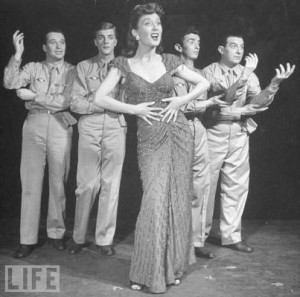
One of the great stories of New York City in the 1940s that our course somehow manages to miss is the tale of Jackie Robinson, the Brooklyn Dodgers, and the integration of major-league baseball.
She was beautiful and I was terrified of her.
— Nancy Macdonald’s memory of the young Mary McCarthy
So far as I know, the lives of Mary McCarthy and Otto Preminger did not overlap in any significant way. They worked in different art forms, moved in very different circles, and had quite disparate interests. But they had one important quality in common. At the center of both The Company She Keeps and Laura lies a distinctive and powerful conjunction. In each we see a fascination with the sexual freedom experienced by well-educated, career women living in New York City. And in both texts, the glamorous and possibly disturbing implications of that freedom are viewed from a narrative perspective that is striking for the analytic distance and emotional neutrality it maintains toward its subject matter. In short, passion viewed dispassionately. Hot and cold.

One of the interesting historical curiosities of Lionel Trilling’s Middle of the Journey is the fact that the novel depends heavily on the figure of Gifford Maxim–a barely fictionalized representation of Trilling’s sometime associate Whittaker Chambers. Chambers was little known in 1947, when Trilling’s book was published. But in the following year he would become a figure of national controversy when he publicly accused State Department official Alger Hiss, among others, of having spied for the Soviet Union. That accusation resulted in a political firestorm and became a central episode of postwar American political history.

The great conservative historian John Lukacs is said to have asked in 1957 whether Dwight Macdonald would not soon be recognized as the American Orwell. The answer turned out to be “probably not.” Macdonald never achieved anything like Orwell’s stature or influence. But the question was a measure of Macdonald’s once great prominence in the American intellectual scene.
The other day in class, Sierra asked whether, given the success of Ann Petry’s protest fiction, The Street had an any effect on the conditions it depicts.

TO OUR READERS The New Yorker this week devotes its entire editorial space to an article on the almost complete obliteration of a city by one atomic bomb, and what happened to the people of that city. It does so in the conviction that few of us have yet comprehended the all but incredible destructive power of this weapon, and that everyone might well take time to consider the terrible implications of its use. The Editors
The notice with which The New Yorker prefaced the special issue containing “Hiroshima”
John Hersey’s “Hiroshima” was initially published in the August 31, 1946 issue of The New Yorker. In a number of respects, the publication was unprecedented for the magazine, and it created a local and national sensation.

Yesterday’s news included an obituary for Betty Garrett, who entered the movie musical patheon as Brunhilde Esterhaszy–the cabbie who woos and wins Frank Sinatra in On the Town. In a small way, Garrett’s career illuminates some of the developments important to our course.